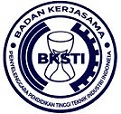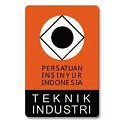Analisis Kepuasan Pelanggan di Enggal Nyawiji dengan Menggunakan Metode Service Quality
Abstract
Penelitian ini bertujuan untuk mengetahui kepuasan pelanggan di Enggal Nyawiji dengan menggunakan metode kualitas pelayanan. Penelitian ini menggunakan pendekatan kuantitatif dan dianalisis dengan menggunakan teknik statistik. Populasi yang digunakan dalam penelitian ini adalah konsumen pengguna jasa UKM percetakan Enggal Nyawiji sebanyak 125 orang dengan sampel sebanyak 68 responden dengan menggunakan teknik Probability Sampling, dan alat ukur sampel dibantu dengan rumus Solvin. Hasil penelitian menyatakan bahwa terdapat 15 atribut yang digunakan dalam penelitian yang menjadi harapan dan persepsi UKM Enggal Nyawiji. Dari 15 atribut yang digunakan, terdapat 13 atribut dengan nilai negatif. 1 atribut netral dan 1 atribut positif. Sehingga dalam penelitian ini dinyatakan bahwa kepuasan pelanggan dengan metode kualitas pelayanan belum mencapai harapan yang diharapkan oleh pelanggan. Hasil penelitian ini merekomendasikan kepada UKM Enggal Nyawiji untuk mempertahankan atribut Attention of Service Officers karena telah mendapat nilai positif, dan meningkatkan Tennis Ability Petugas Service serta mengevaluasi 13 atribut lainnya yang belum memenuhi harapan pelanggan.
Full Text:
PDFReferences
Y. Zhang, “Privacy-preserving quality prediction for edge-based IoT services,” Futur. Gener. Comput. Syst., vol. 114, pp. 336–348, 2021, doi: 10.1016/j.future.2020.08.014.
C. Pelau, “What makes an AI device human-like? The role of interaction quality, empathy and perceived psychological anthropomorphic characteristics in the acceptance of artificial intelligence in the service industry,” Comput. Human Behav., vol. 122, 2021, doi: 10.1016/j.chb.2021.106855.
L. Wang, “Pythagorean fuzzy interactive Hamacher power aggregation operators for assessment of express service quality with entropy weight,” Soft Comput., vol. 25, no. 2, pp. 973–993, 2021, doi: 10.1007/s00500-020-05193-z.
S. A. Qalati, “Effects of perceived service quality, website quality, and reputation on purchase intention: The mediating and moderating roles of trust and perceived risk in online shopping,” Cogent Bus. Manag., vol. 8, no. 1, 2021, doi: 10.1080/23311975.2020.1869363.
R. W. Liu, “Data-driven trajectory quality improvement for promoting intelligent vessel traffic services in 6g-enabled maritime iot systems,” IEEE Internet Things J., vol. 8, no. 7, pp. 5374–5385, 2021, doi: 10.1109/JIOT.2020.3028743.
M. Bakir, “Application of fuzzy ahp and fuzzy marcos approach for the evaluation of e-service quality in the airline industry,” Decis. Mak. Appl. Manag. Eng., vol. 4, no. 1, pp. 127–152, 2021, doi: 10.31181/dmame2104127b.
M. T. Alshurideh, “Does electronic customer relationship management (E-CRM) affect service quality at private hospitals in Jordan?,” Uncertain Supply Chain Manag., vol. 10, no. 2, pp. 325–332, 2022, doi: 10.5267/j.uscm.2022.1.006.
Y. Zhang, “Covering-Based Web Service Quality Prediction via Neighborhood-Aware Matrix Factorization,” IEEE Trans. Serv. Comput., vol. 14, no. 5, pp. 1333–1344, 2021, doi: 10.1109/TSC.2019.2891517.
M. U. H. Uzir, “The effects of service quality, perceived value and trust in home delivery service personnel on customer satisfaction: Evidence from a developing country,” J. Retail. Consum. Serv., vol. 63, 2021, doi: 10.1016/j.jretconser.2021.102721.
F. Li, “Customer satisfaction with bank services: The role of cloud services, security, e-learning and service quality,” Technol. Soc., vol. 64, 2021, doi: 10.1016/j.techsoc.2020.101487.
S. S. Lubis, “Identify Financial Ratios to Measure The Company’s Financial Performance,” J. Econ. Bus. Ind., vol. 1, no. 1, pp. 1–10, 2023.
M. Rathee, “Ant Colony Optimization Based Quality of Service Aware Energy Balancing Secure Routing Algorithm for Wireless Sensor Networks,” IEEE Trans. Eng. Manag., vol. 68, no. 1, pp. 170–182, 2021, doi: 10.1109/TEM.2019.2953889.
Y. Yingfei, “Green logistics performance and infrastructure on service trade and environment-Measuring firm’s performance and service quality,” J. King Saud Univ. - Sci., vol. 34, no. 1, 2022, doi: 10.1016/j.jksus.2021.101683.
T. M. Sari and W. Dini, “Risk Assessment and Mitigation Strategy in The Halal Broiler Supply Chain,” J. Ris. Ilmu Tek., vol. 1, no. 1, pp. 13–24, 2023.
F. Pohan, I. Saputra, and R. Tua, “Scheduling Preventive Maintenance to Determine Maintenance Actions on Screw Press Machine,” J. Ris. Ilmu Tek., vol. 1, no. 1, pp. 1–12, 2023.
V. C. Dewi, V. Amrizal, and F. E. M. Agustin, “Implementation of Adaptive Neuro-Fuzzy Inference System and Image Processing for Design Applications Paper Age Prediction,” J. Ris. Ilmu Tek., vol. 1, no. 1, pp. 45–57, 2023.
I. N. Permadi and D. B. Nisa, “A Model Experiment Design Using the Taguchi Method: A Case Study Of Making Concrete Roof,” J. Ris. Ilmu Tek., vol. 1, no. 1, pp. 36–44, 2023.
G. Filhaq, S. Aprianto, and H. Alfianto, “Design of Smart Locker Door Using Quality Function Deployment Based on ATMega 2560 Microcontroller,” J. Ris. Ilmu Tek., vol. 1, no. 1, pp. 25–35, 2023.
N. Iqbal, “A Novel Blockchain-Based Integrity and Reliable Veterinary Clinic Information Management System Using Predictive Analytics for Provisioning of Quality Health Services,” IEEE Access, vol. 9, pp. 8069–8098, 2021, doi: 10.1109/ACCESS.2021.3049325.
C. C. Cheng, “Construction of a service quality scale for the online food delivery industry,” Int. J. Hosp. Manag., vol. 95, 2021, doi: 10.1016/j.ijhm.2021.102938.
Q. Liu, “Secure Multi-keyword Fuzzy Searches with Enhanced Service Quality in Cloud Computing,” IEEE Trans. Netw. Serv. Manag., vol. 18, no. 2, pp. 2046–2062, 2021, doi: 10.1109/TNSM.2020.3045467.
D. C. Ferreira, “Public-private partnerships in health care services: Do they outperform public hospitals regarding quality and access? Evidence from Portugal,” Socioecon. Plann. Sci., vol. 73, 2021, doi: 10.1016/j.seps.2020.100798.
Y. Kim, “Do information and service quality affect perceived privacy protection, satisfaction, and loyalty? Evidence from a Chinese O2O-based mobile shopping application,” Telemat. Informatics, vol. 56, 2021, doi: 10.1016/j.tele.2020.101483.
E. Tumsekcali, “Interval valued intuitionistic fuzzy AHP-WASPAS based public transportation service quality evaluation by a new extension of SERVQUAL Model: P-SERVQUAL 4.0,” Expert Syst. Appl., vol. 186, 2021, doi: 10.1016/j.eswa.2021.115757.
DOI: http://dx.doi.org/10.24014/jti.v9i2.23924
Refbacks
- There are currently no refbacks.
Copyright (c) 2023

This work is licensed under a Creative Commons Attribution-NonCommercial-ShareAlike 4.0 International License.
Jurnal Teknik Industri
P-ISSN 2460-898X | E-ISSN 2714-6235
Published by:
Industrial Engineering Department
Universitas Islam Negeri Sultan Syarif Kasim Riau, Indonesia
Office Address:
H.R. Soebrantas KM 15.5, Tampan, Pekanbaru, Riau, Indonesia 28293
email: jti.fst@uin-suska.ac.id
Indexed by:
JTI : Jurnal Teknik Industri under a Creative Commons Attribution-NonCommercial-ShareAlike 4.0 International License.

















